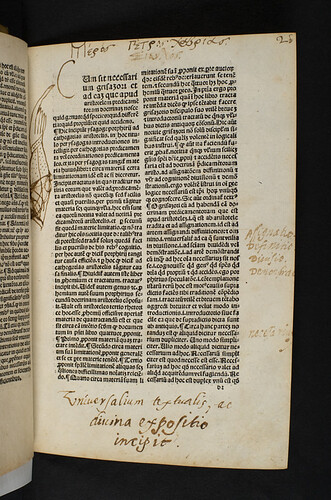Magistri, Martinus: Expositio super Praedicabilia Porphyrii.
Paris: Félix Baligault, for Durand Gerlier, 27 Mar. 1499.
4to. a-k8 l-m6. [92] leaves (m6 blank).
Gerlier’s woodcut device (P. Renouard, 'Les marques typographiques parisiennes des XVe et XVIe siècles', 361) on a1r.
ISTC im00022300; GW M19866; Sack(Freiburg) 2297; CIBN M-12.
| GIP number: | M3 |
| Shelf-mark: | Sp Coll BC33-d.8 (see main library entry for this item) |
| Bound with: | The first of eight incunabula bound together. Bound with: (2) Bricot, Thomas, Insolubilia; Obligationes. Paris: [André Bocard], 1498 (B107); (3) Limos, Andreas, Dubia in insolubilibus. Paris: Félix Baligault, for Gilles de Gourmont, 30 Oct. 1499 (L26); (4) Alliaco, Petrus de, Conceptus et insolubilia. Paris: Guy Marchant, 29 Jan. 1498/99 (A45); (5) Buridanus, Johannes, Sophismata. Paris: Félix Baligault, 20 Nov. 1493 (B115); (6) Alliaco, Petrus de, Tractatus exponibilium. Paris: Antoine Caillaut, [ca. 1497] (A49); (7) Buridanus, Johannes, Consequentiae. Paris: Antoine Caillaut [ca. 1495] (B113); (8) Buridanus, Johannes, Consequentiae. Paris: Guy Marchant, 10 Jan. 1498/99 (B114). |
| Provenance: | Anthonius Rogant/Rogantus (fl. 1537), of Montpellier: inscription “Anthonius Rogant” (scored through in ink) and “Rogant” (lightly washed over in ink) on a1r. Petrus Chabrias (fl. 1537): inscription “Petrus Chabrias” on c7r; inscription in Greek on d2r “Μερος Πετρος Χαβριας Σικυλος” (Σικυλος [sic] partially erased); another inscription in Greek on m5v “Πετρος Χαβριας Σικυλος” (Σικυλος partially erased); a similar Greek inscription denoting Chabrias’s ownership on a1r where Chabrias has also added in Latin “In hoc volumine continentur octo librj diuersor[um] Author[um] et materiarum” and “Hic octo continentur opuscula”; initial “C” in shape of a crescent moon with human face added in brown ink on a2r bordered with a largely erased inscription in Greek “Μερος Πετρος Χαβριας Σικυλος”. Frater Joannes Batt[ist]a(?) (16th century): inscription “Ad vsu[m] fratris Jo: Battãe a Calatagne” on a1r. Naples, Capuchins, S. Ephrem and BVM (founded 1572, suppressed 1863): on a1r is a circular book-stamp ‘BIBLIOTECAE CAPVCCINORVM CONCEPTIONIS NEAPOLIS’ heavily scored through in ink and, on the same page, a partially deleted manuscript inscription indicating the same ownership; see www.bnnonline.it/index.php?it/324/possessori/possessori_508e7ec2a179d/58 William Laing (1764-1832), Edinburgh bookseller: possibly sold book to Richard Heber – see below. Richard Heber (1774-1833), book collector: lot 5288 in Bibliotheca Heberiana, Pt. 5 (London: Wheatley, 1835); sold for £0.2.0 according to the priced copy of the Heber sale catalogue in the British Library (shelfmark RAR 002.092 Heb), which also records that Heber himself paid £0.3.0 for the book - corroborated by a note in ink by Heber on front flyleaf “Feb. 181[2?] Laing(?) Sale of Imp[ortant](?) Books - 3 -”. Sir William Hamilton (1788-1856), Professor of Logic and Metaphysics, University of Edinburgh: purchased at the Heber sale, with Hamilton’s pencil note on front flyleaf “Hebers Sale 2/”. University of Glasgow: Hamilton collection donation, 1878. |
| Binding: | Italy, 16th/17th-century parchment; faded ink spine title and shelfmark “148” at foot of spine, faded unread lettering at head of spine; front endpapers replaced in late 19th or early 20th century. Size: 215 x 145 mm. |
| Leaf size: | 203 x 135 mm. |
| Annotations: | Notes in Italian in the hand of Petrus Chabrias on “il sommo bene” on a1v; numerous marginal annotations (cropped by binder) up to d3v in Latin, also in the hand of Petrus Chabrias; occasional marginal notes in Latin in a different 16th-century hand; foliated from a2r to m5r “1”-“90” in a 16th-century hand. |
| Decoration: | Green colouring added to printer’s device on a1r; initial “C” with manicule supplied in brown ink on d2r. |
| Imperfections: | None. |





